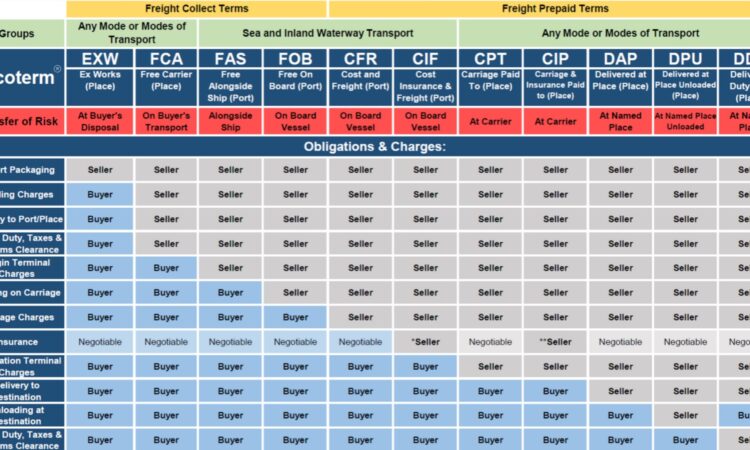What are Incoterms?
Understanding Incoterms® is a vital part of International Trade.
Put simply, Incoterms® are the selling terms that the buyer and seller of goods both agrees to. The Incoterm® clearly states which tasks, costs and risks are associated with the buyer and the seller. The Incoterm® is agreed between the buyer and seller and states when the seller’s costs and risks are then transferred onto the buyer.
Incoterms® are also referred to as International Commercial Terms, which are published by the International Chamber of Commerce (ICC), which relate to International Commercial Law. They are accepted by governments and legal authorities around the world. The ICC published new Incoterms® 2020 that have come into effect from the 1st of January 2020. The ICC originally published Incoterms® in 1936 and have continually published updates to reflect the changes to the Global Trade environment. It’s important that all parties involved in trade clearly understand the changes and how they apply to global supply chains.
The below chart displays Incoterms® 2020 in an easy to understand format. Our chart states each Incoterm® and explains the obligations and charges that are accepted by the seller and the buyer. This is general information for guidance purposes only. For a full and complete description, refer to the full version of Incoterms® 2020 by the International Chamber of Commerce at the ICC website.
incoterm table
Rules for any mode or modes of transport
EXW – Ex-Works or Ex-Warehouse
“Ex Works” means that the seller delivers when it places the goods at the disposal of the buyer at the seller’s premises or at another named place (i.e.,works, factory, warehouse, etc.). The seller does not need to load the goods on any collecting vehicle, nor does it need to clear the goods for export, where such clearance is applicable.
FCA – Free Carrier
“Free Carrier” means that the seller delivers the goods to the carrier or another person nominated by the buyer at the seller’s premises or another named place. The parties are well advised to specify as clearly as possible the point within the named place of delivery, as the risk passes to the buyer at that point.
CPT (Carriage Paid To)
“Carriage Paid To” means that the seller delivers the goods to the carrier or another person nominated by the seller at an agreed place (if any such place is agreed between parties) and that the seller must contract for and pay the costs of carriage necessary to bring the goods to the named place of destination.
CIP (Carriage & Insurance Paid to)
“Carriage and Insurance Paid to” means that the seller delivers the goods to the carrier or another person nominated by the seller at an agreed place (if any such place is agreed between parties) and that the seller must contract for and pay the costs of carriage necessary to bring the goods to the named place of destination.
‘The seller also contracts for insurance cover against the buyer’s risk of loss of or damage to the goods during the carriage. The buyer should note that under CIP the seller is required to obtain insurance only on minimum cover. Should the buyer wish to have more insurance protection, it will need either to agree as much expressly with the seller or to make its own extra insurance arrangements.”
DAP – Delivered At Place
“Delivered at Place” means that the seller delivers when the goods are placed at the disposal of the buyer on the arriving means of transport ready for unloading at the named place of destination. The seller bears all risks involved in bringing the goods to the named place.
DPU – Delivered At Place Unloaded
“Delivered At Place Unloaded” means that the seller delivers when the goods, once unloaded, are placed at the disposal of the buyer at a named place of destination. The seller bears all risks involved in bringing the goods to, and unloading them at the named place of destination.
DDP (Delivered Duty Paid)
“Delivered Duty Paid” means that the seller delivers the goods when the goods are placed at the disposal of the buyer, cleared for import on the arriving means of transport ready for unloading at the named place of destination. The seller bears all the costs and risks involved in bringing the goods to the place of destination and has an obligation to clear the goods not only for export but also for import, to pay any duty for both export and import and to carry out all customs formalities.
Rules for sea and inland waterway transport:
FOB (Free on Board)
“Free On Board” means that the seller delivers the goods on board the vessel nominated by the buyer at the named port of shipment or procures the goods already so delivered. The risk of loss of or damage to the goods passes when the goods are on board the vessel, and the buyer bears all costs from that moment onwards.
CFR (Cost & Freight)
“Cost and Freight” means that the seller delivers the goods on board the vessel or procures the goods already so delivered. The risk of loss of or damage to the goods passes when the goods are on board the vessel. the seller must contract for and pay the costs and freight necessary to bring the goods to the named port of destination.
CIF (Cost Insurance & Freight)
“Cost, Insurance and Freight” means that the seller delivers the goods on board the vessel or procures the goods already so delivered. The risk of loss of or damage to the goods passes when the goods are on board the vessel. The seller must contract for and pay the costs and freight necessary to bring the goods to the named port of destination.
‘The seller also contracts for insurance cover against the buyer’s risk of loss of or damage to the goods during the carriage. The buyer should note that under CIF the seller is required to obtain insurance only on minimum cover. Should the buyer wish to have more insurance protection, it will need either to agree as much expressly with the seller or to make its own extra insurance arrangements.”
FAS (Free Alongside Ship)
“Free Alongside Ship” means that the seller delivers when the goods are placed alongside the vessel (e.g., on a quay or a barge) nominated by the buyer at the named port of shipment. The risk of loss of or damage to the goods passes when the goods are alongside the ship, and the buyer bears all costs from that moment onwards.

